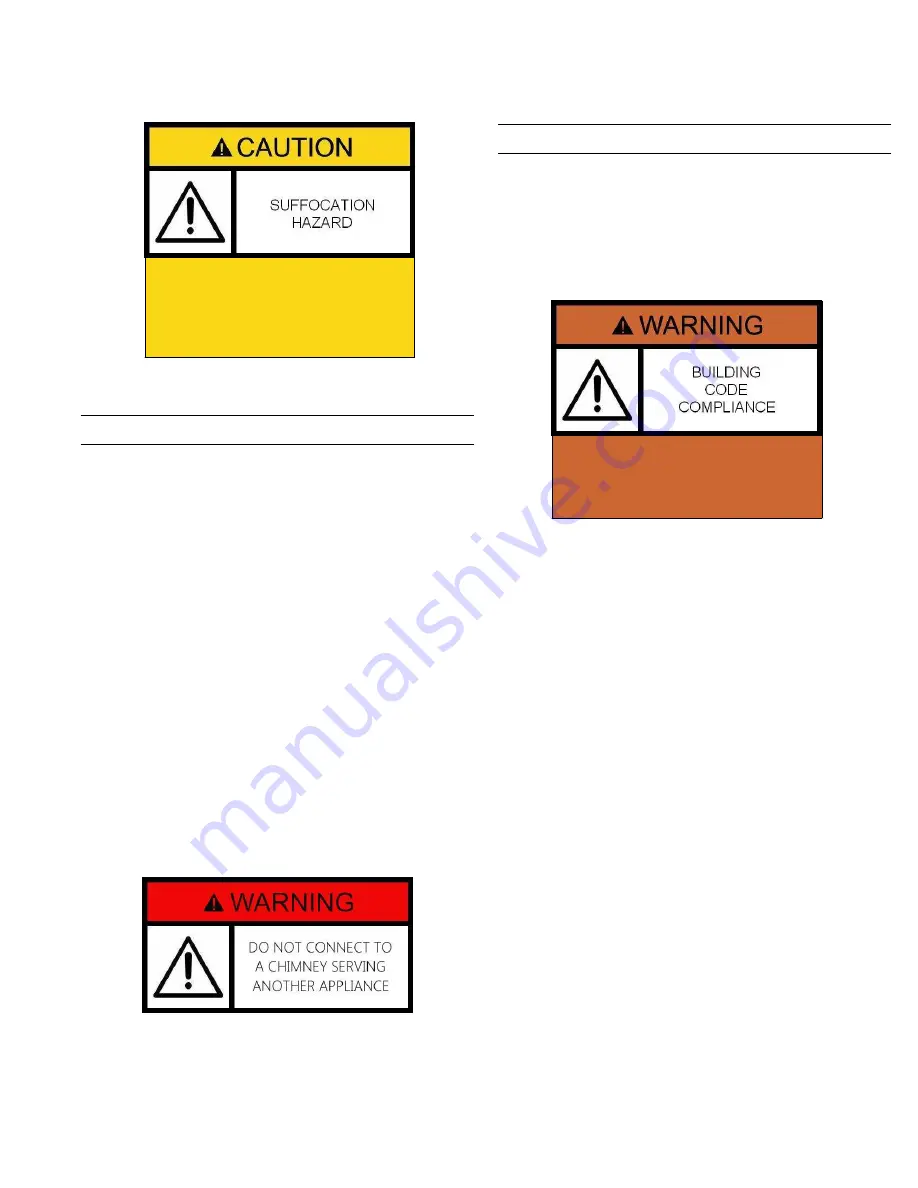
the boiler. In such situations, it may be important to
provide for some heating of this air.
FLUE PIPE
Use only 24 gauge pipe or heavier for Gue
connections. We recommend stainless steel. Heavy
gauge black pipe will not last very long, typically
only one or two years. Galvanized pipe is not
recommended. When using single wall Gue pipe in
open areas, assure the pipe passes no closer than 18
inches from combustible walls or ceiling. If the Gue
pipe must be closer than 18 inches from the nearest
wall or ceiling, or if it must go through walls, closets,
or boxed-in areas, then U.L. listed insulated Gue pipe
must be used. Flue pipe that runs along the outside
walls of a building must also be U.L. listed insulated
pipe, even if it runs along a non-combustible outside
wall.
is requirement is in place in order to prevent
cooling of the Gue pipe, which in turn cools the
rising smoke and causes condensation and creosote
to form quickly.
Do not connect more than one heating appliance
to a single chimney. Be sure to check all local codes
and your insurance provider’s requirements for any
additional restrictions and/or guidelines regarding
your Gue pipe.
PROPER CHIMNEY CONNECTION
e boiler must be connected to a class A
chimney.
e recommended method for connecting
the boiler to the chimney is to place a T-joint at the
top of the vertical section leading from the cyclone.
Each joint should be secured with three sheet metal
screws and sealed with high temperature furnace
cement or “Troweleze” refractory cement or High
Temperature Silicone.
e opening on the T-joint
should be 7ed with a removable cap to enable
cleaning and inspection. If the horizontal run to the
chimney is inclined, it will encourage any Gy ash
which drops in the pipe to fall back into the ash
separator. In many cases it is acceptable to set the
stack directly on the cyclone, as long as provision is
made for removal, and the length of pipe supported
only by the cyclone is eight feet or less. If a taller run
is required additional support is needed.
is can be
provided by ceiling and/or roof supports.
If a second change of direction is required before
entering the chimney a cleanout “T” should be
placed at this point also as indicated in Figure 1. Any
horizontal pipe should be pitched upward toward the
chimney at least ¼ in for each foot of horizontal run.
Be sure there are at least 18 in clearance between
horizontal piping and combustible ceiling. Be sure
that the chimney connection pipe extends at least 2
in into the chimney, but does not extend so far into
the chimney that it blocks airGow.
- 9 -
Use of aluminum Type B gas vent
for solid fuels is unsafe and
prohibited by the National Fire
Protection Association Code.
The airflow through the system and
out the chimney means that oxygen
is leaving the home and will create
an oxygen deficit if this air is not
replaced.
Summary of Contents for wood gun E100 SF
Page 2: ......
Page 24: ...Photo Smoke flap installed 19 ...
Page 46: ...Steel Center Brick 8 Inch 41 ...
Page 49: ...Appendix A Boiler Specification Diagram 44 ...
Page 50: ... 45 ...
Page 51: ... 46 ...
Page 53: ...Appendix B Wiring Diagrams 48 ...
Page 54: ... 49 ...
Page 55: ... 50 ...
Page 56: ... 51 ...
Page 57: ... 52 ...
Page 58: ... 53 ...
Page 59: ... 54 ...
Page 60: ... 55 ...
Page 61: ...Appendix C Exploded Parts Drawings 56 ...
Page 63: ... 58 ...
Page 68: ...Appendix F Boiler Piping and Ducting Examples 63 ...















































